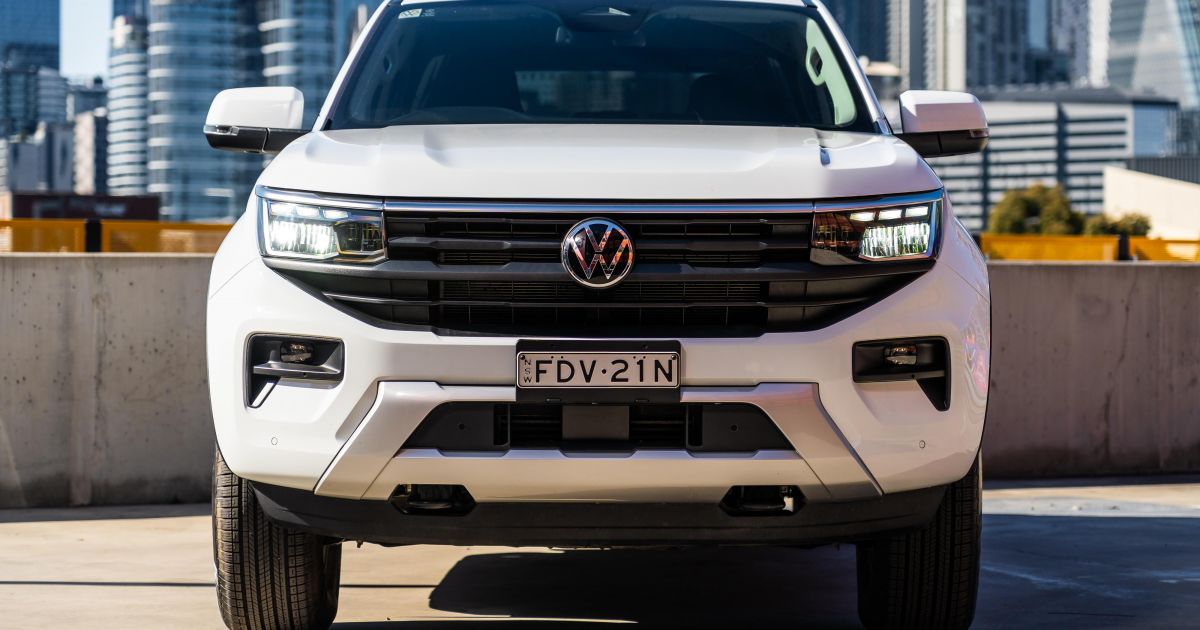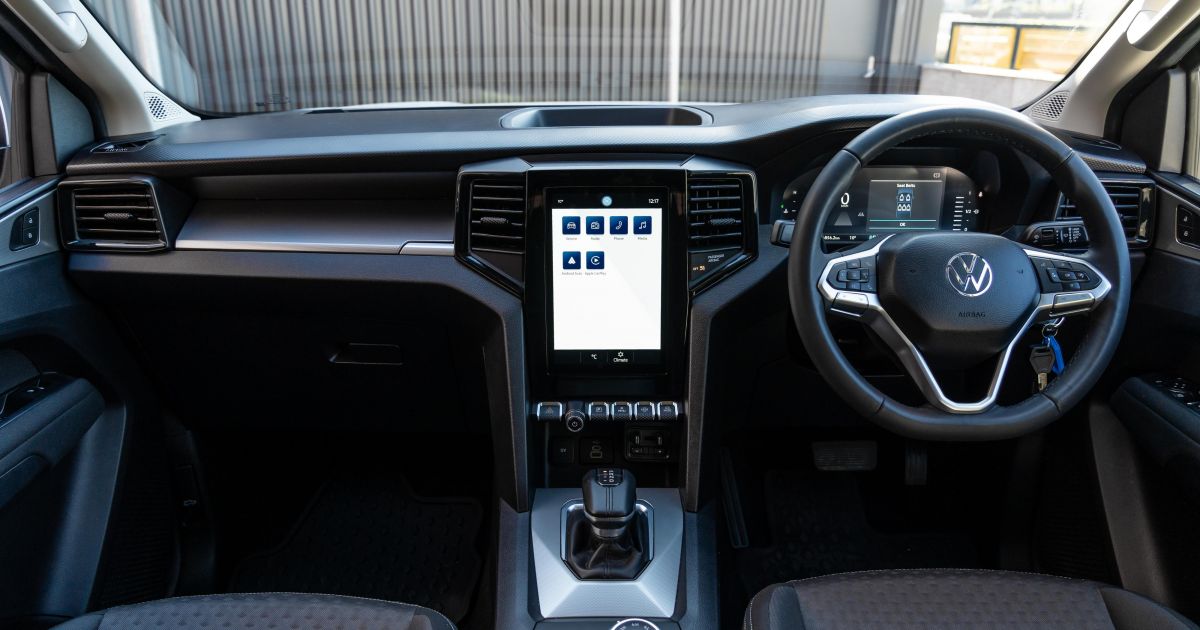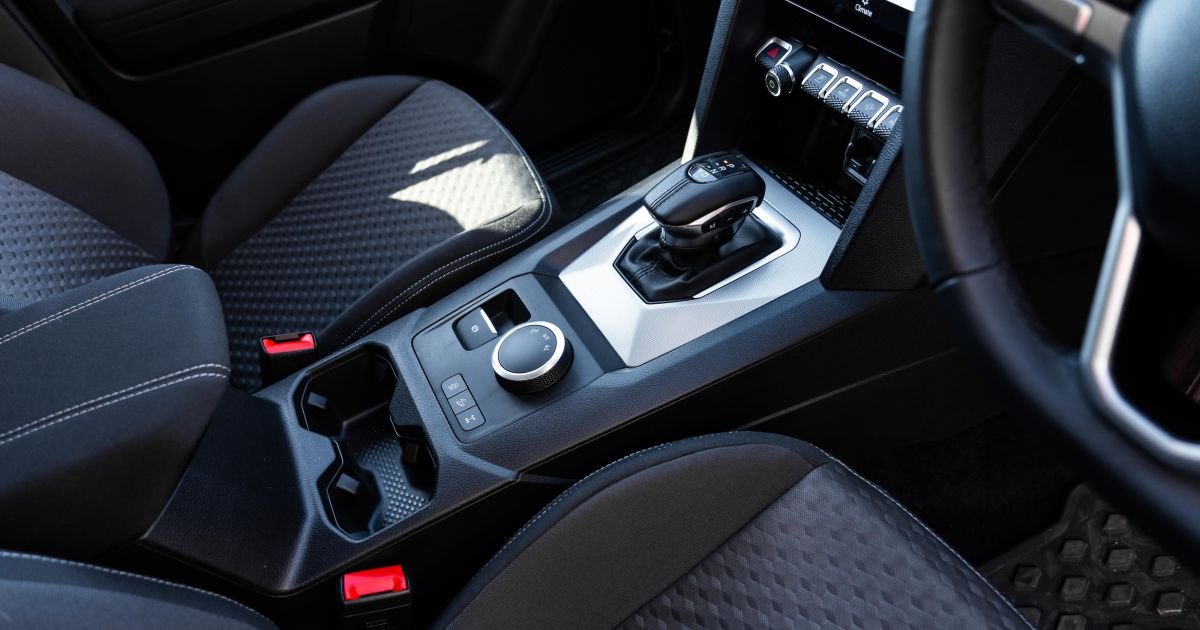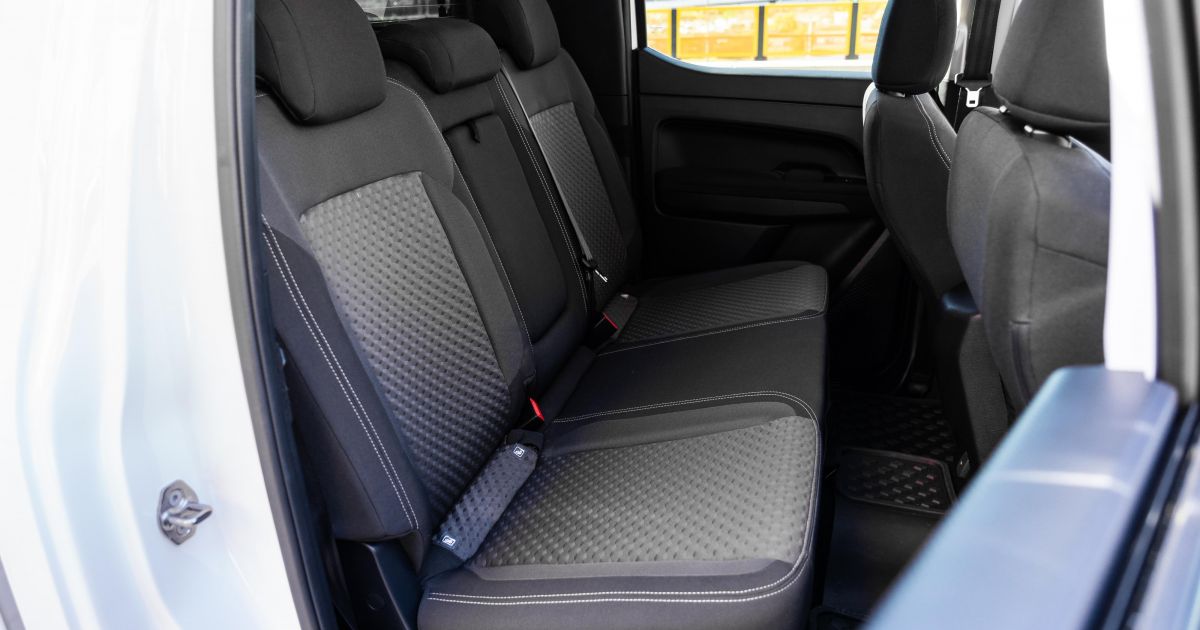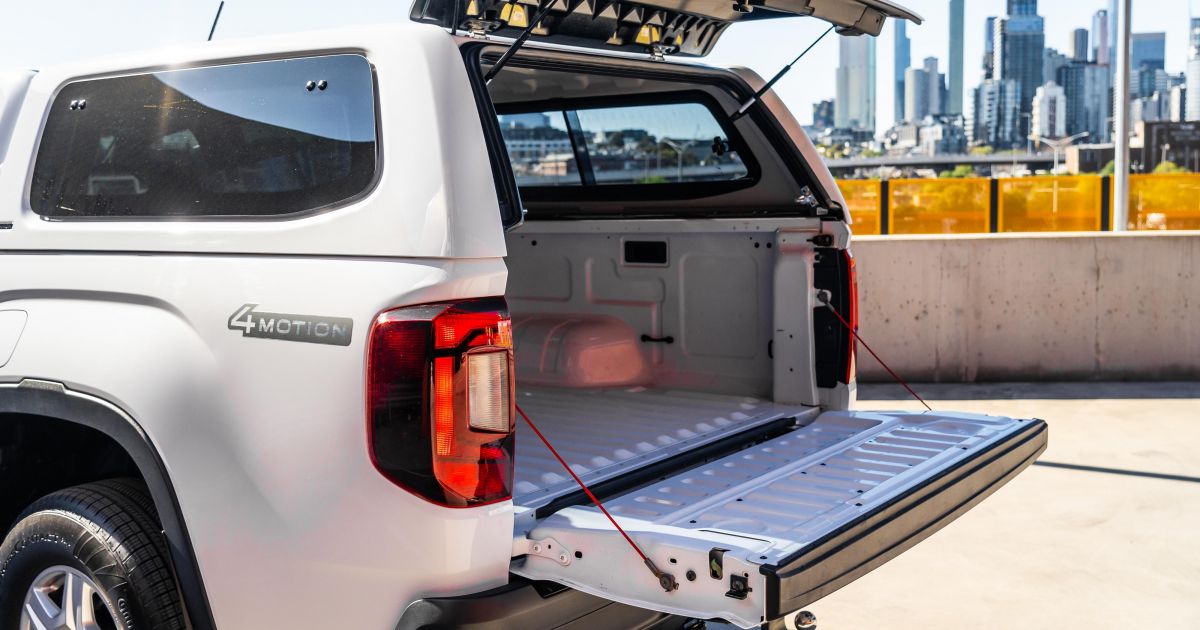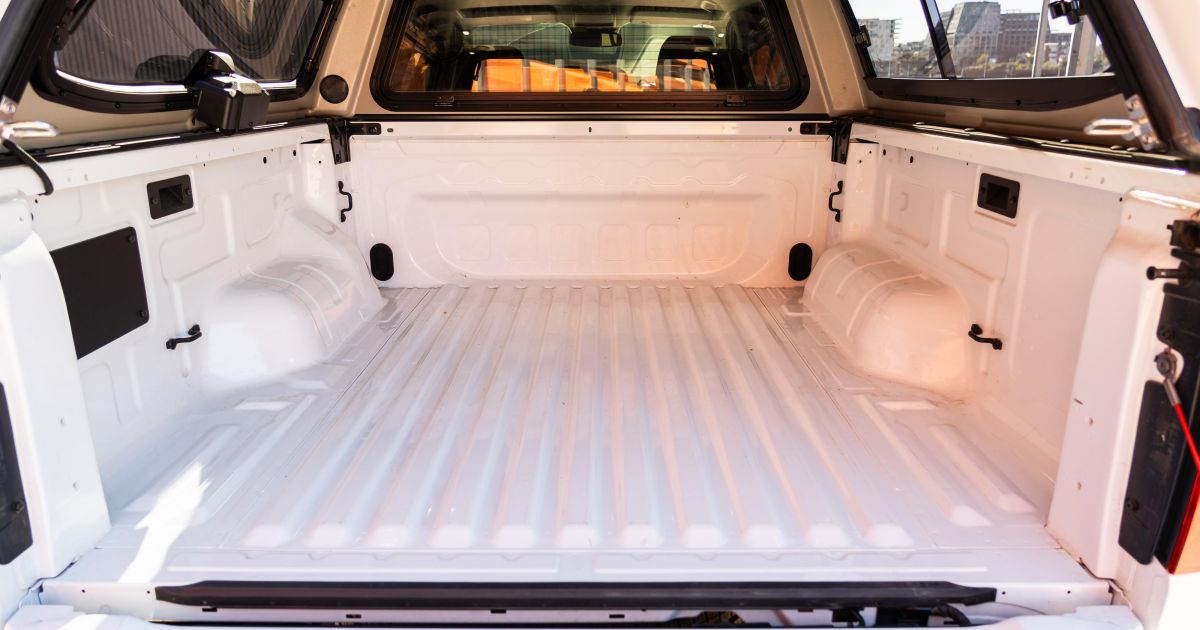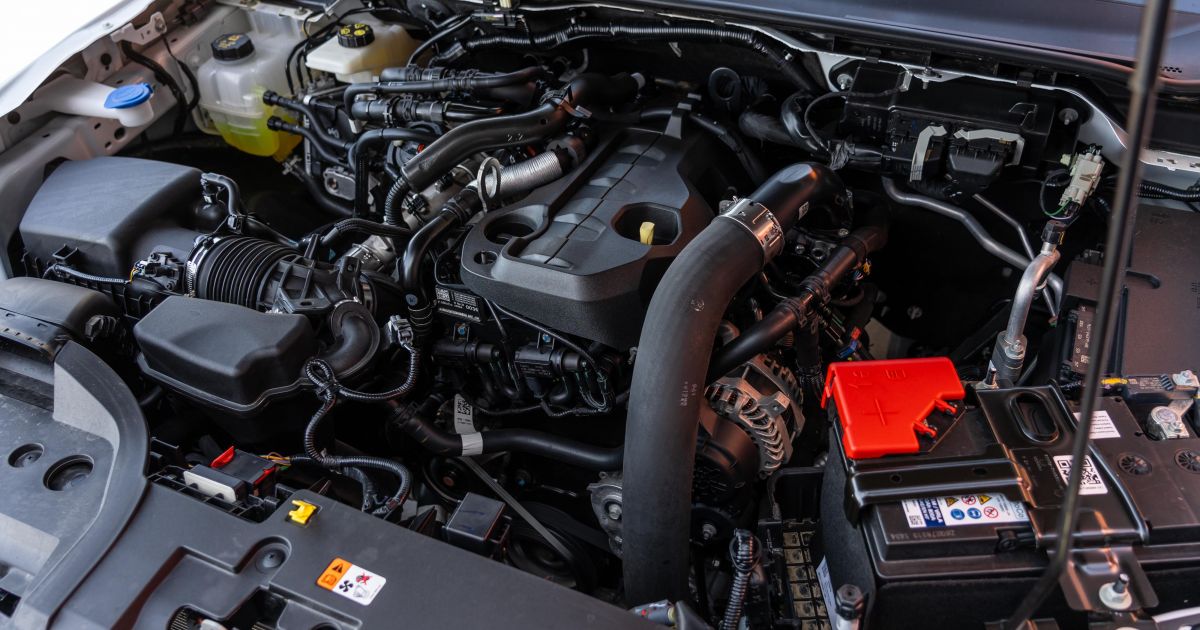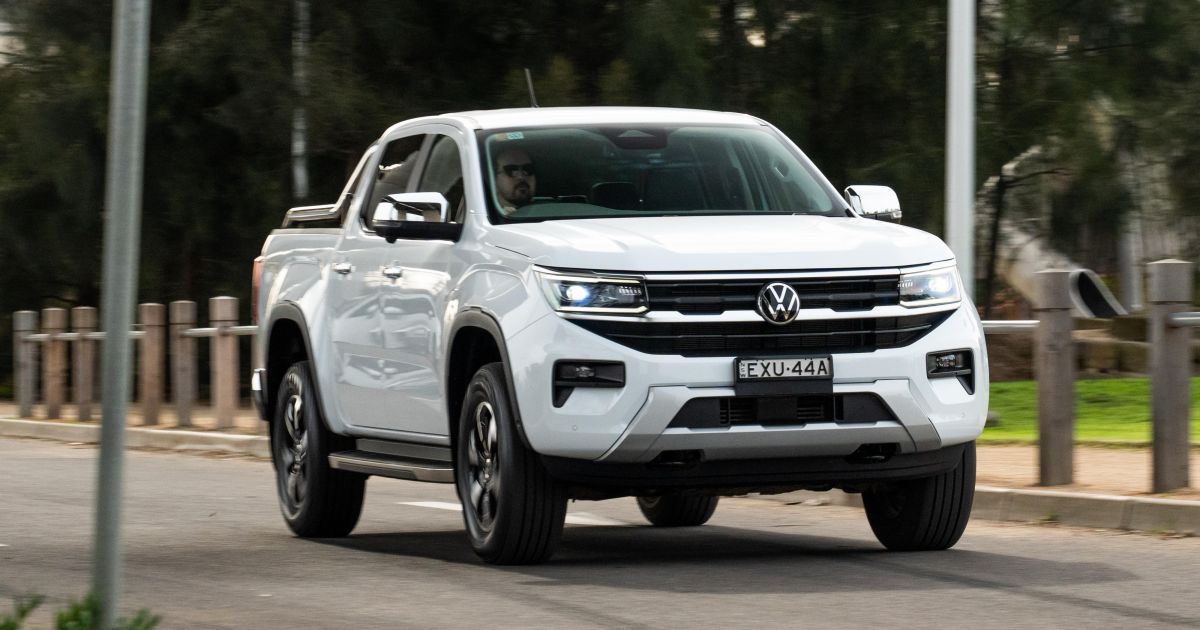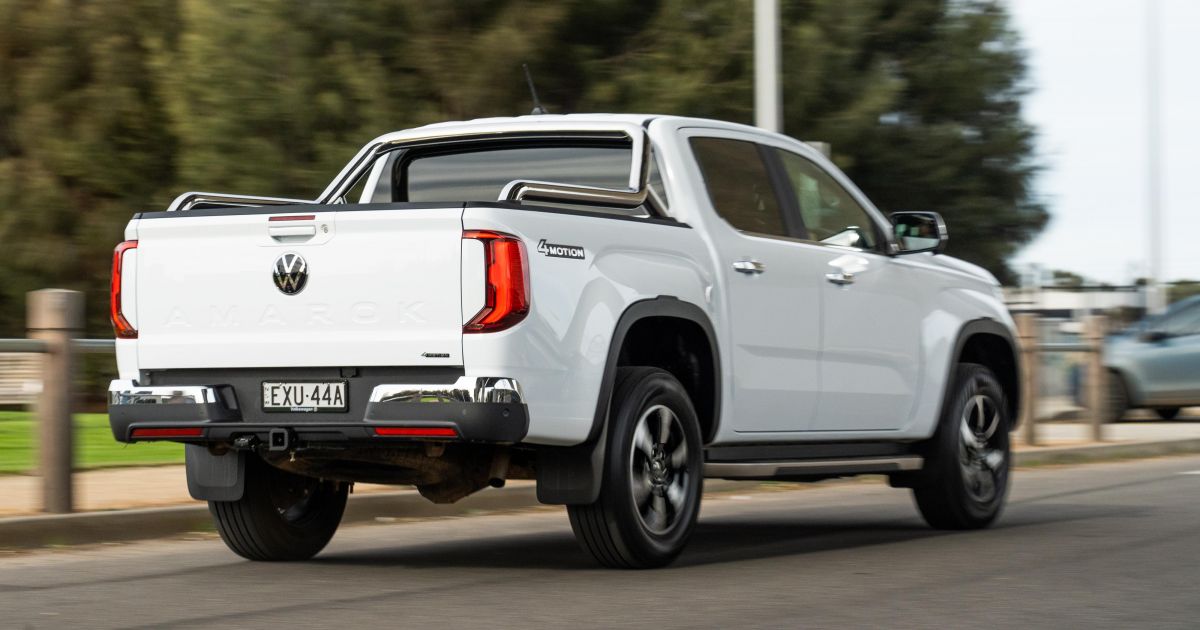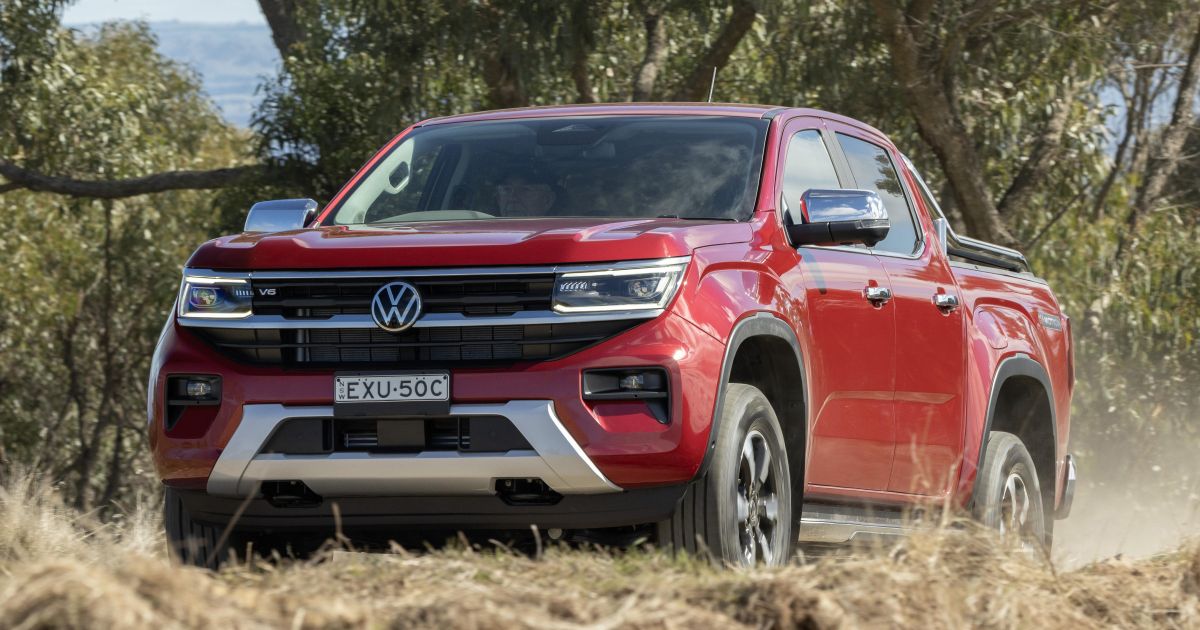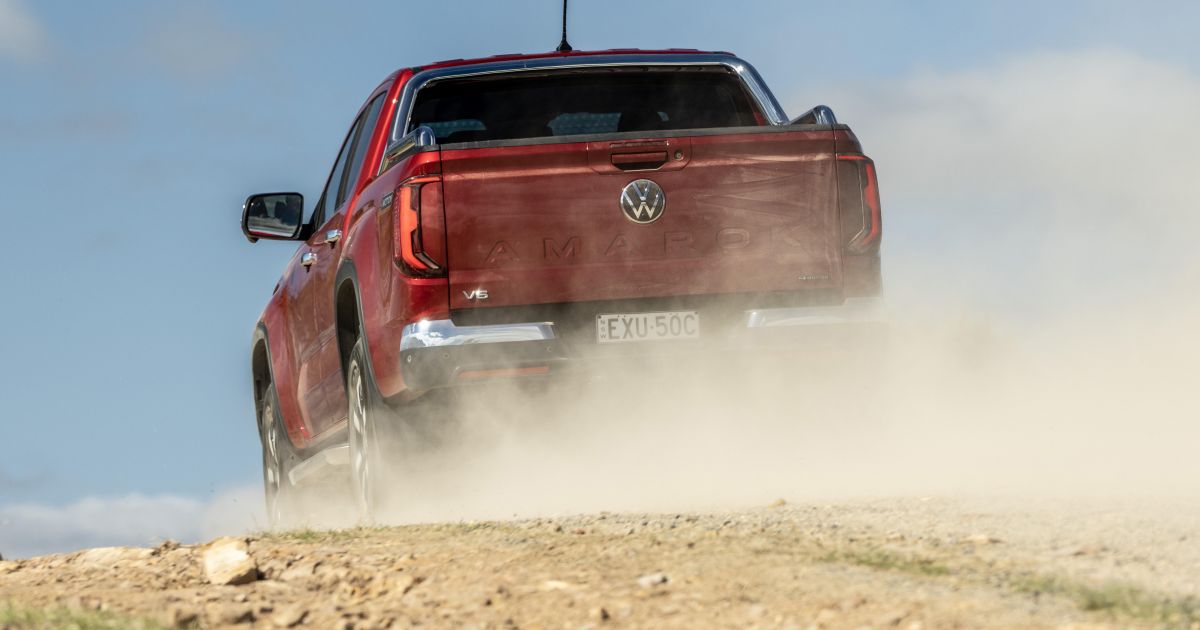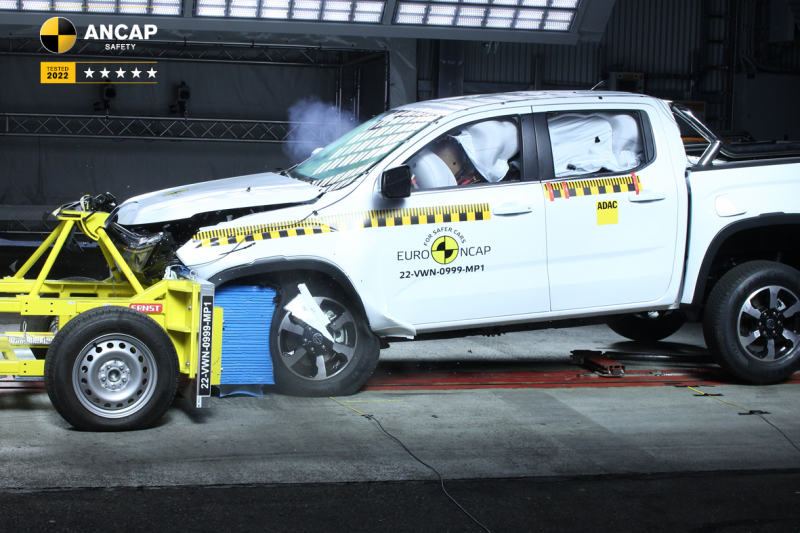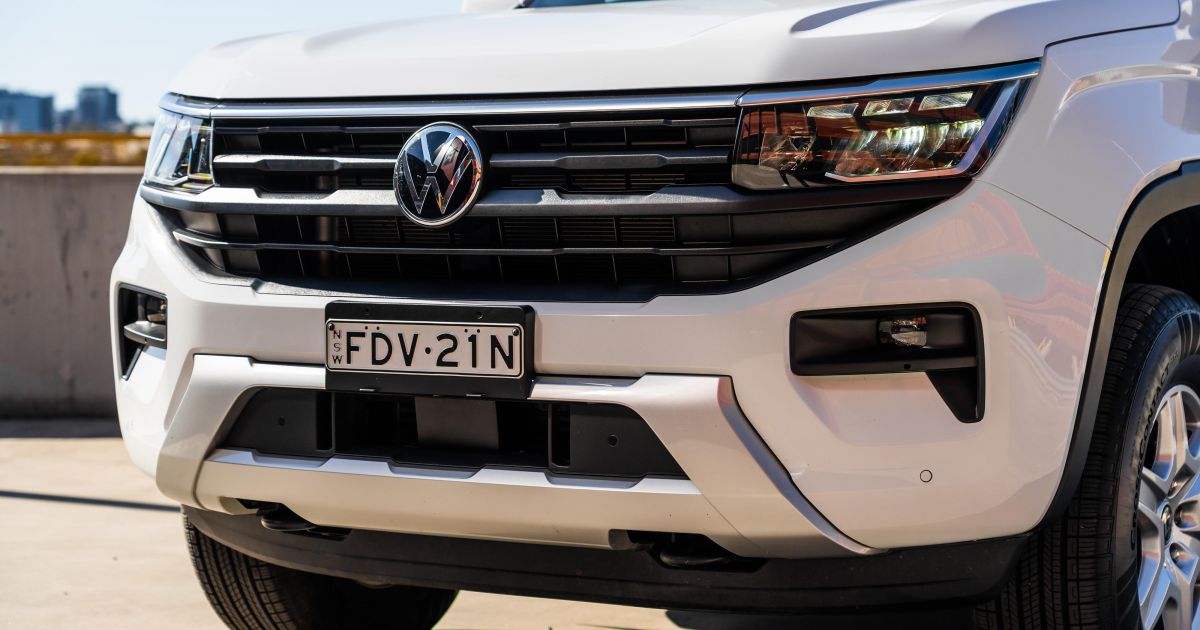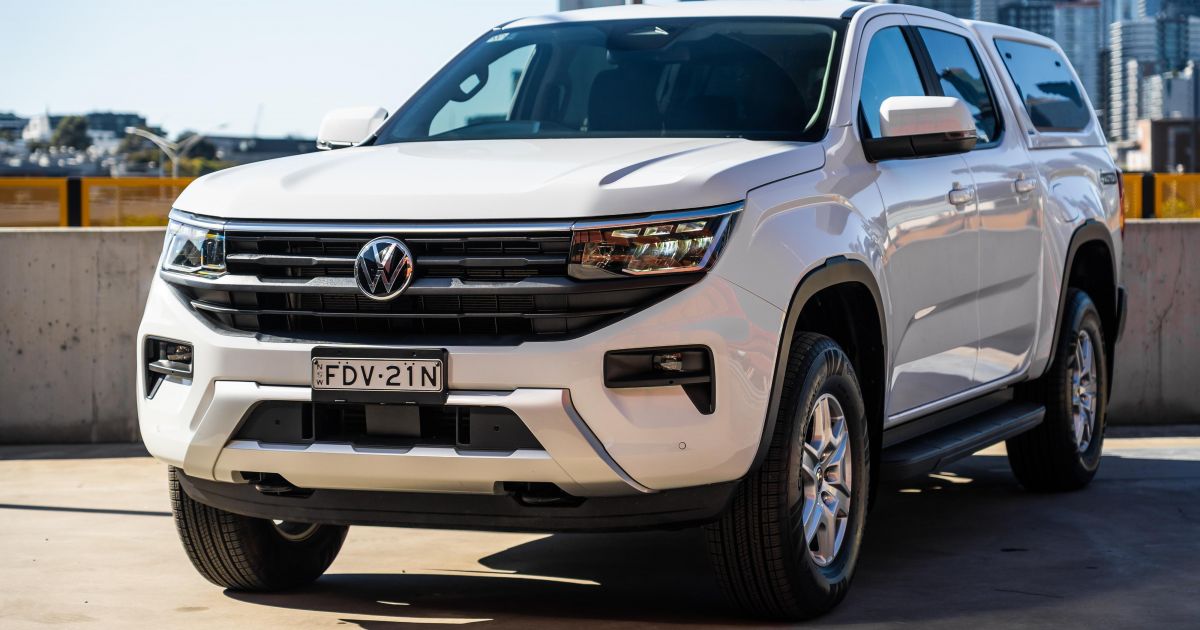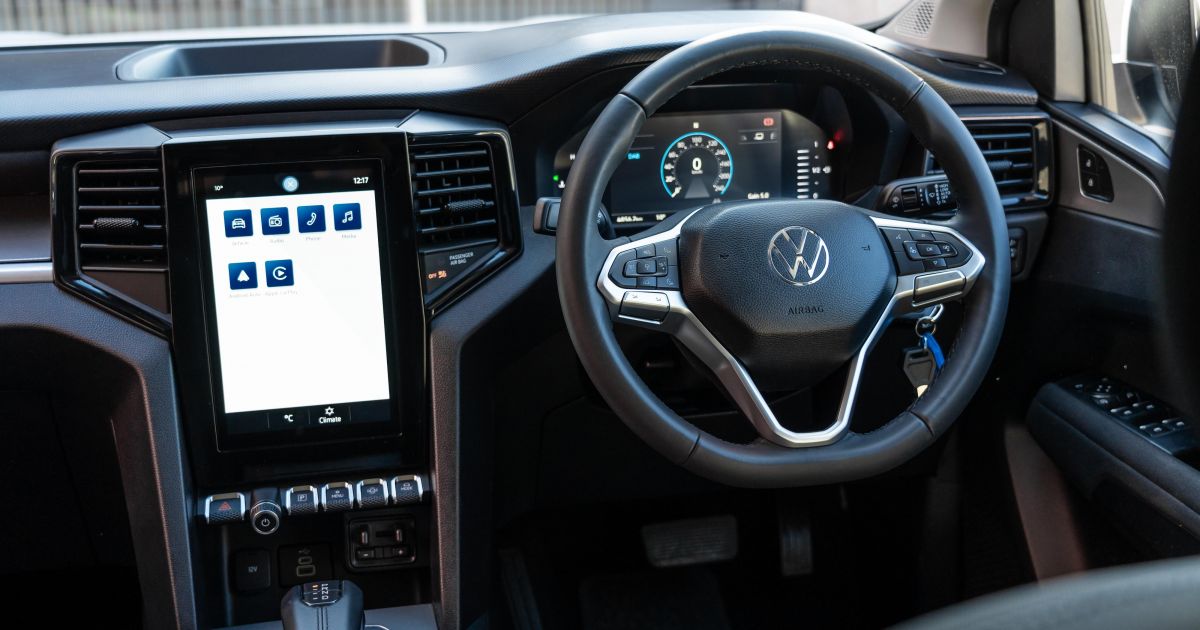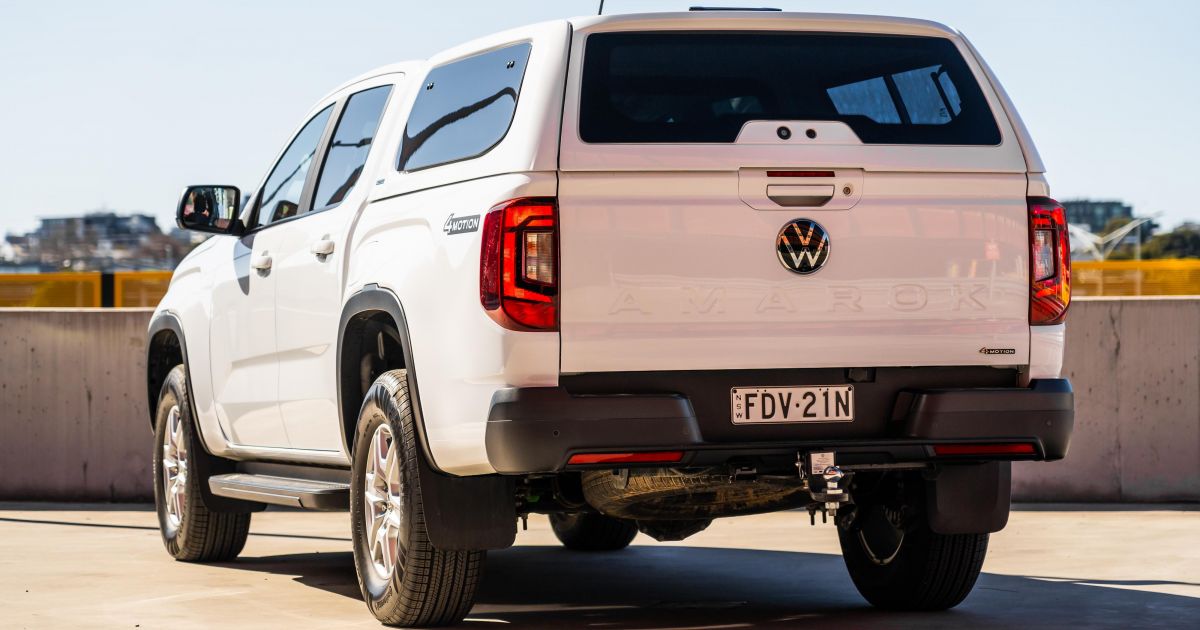The Volkswagen Amarok continues to be an underdog in Australia’s huge ute market, even if it shares its DNA with the country’s current head honcho.
Its twin-under-the-skin is, of course, the Ford Ranger, which not only continues to be Australia’s top-selling ute, but also the country’s favourite new vehicle bar none, with no fewer than 22,000 examples sold so far in 2025.
The Amarok, meantime, has found 2434 new homes in the same period, making it the lowest-selling established ute nameplate locally. Of course, unlike almost all of its rivals, the second-generation Amarok is available in Australia exclusively in dual-cab 4×4 ute form, meaning there’s no single-cab or extended cab versions, and no manual or 4×2 options, so there’s a smaller range with higher prices and more equipment to reflect its premium positioning.
But there’s also increasing competition in the ute market, including from new rivals like the BYD Shark 6 and other cheaper Chinese dual-cabs, as well as overhauls for popular models like the Mitsubishi Triton and range expansions for utes like the Ranger, with the addition of four plug-in hybrid (PHEV) variants. And there’s still no concrete word on a similar powertrain for the Amarok.
Volkswagen’s ute did bring a recent MY25 update that shifted some pricing and specifications, and added a tray option to several variants to create the first double-cab/chassis versions. Hardly groundbreaking updates, but did they need to be?
WATCH: Paul’s video review of the Volkswagen Amarok Life
The Amarok already offered one of the more diverse powertrain lineups of any ute in Australia, even without electrification. There are three turbo-diesel powertrains including a V6, and turbo-petrol engine that not even the Ranger offers here, despite the fact it traces its roots to high-performance Fords like the Focus ST and Mustang EcoBoost.
On test here, however, is the 2025 Volkswagen Amarok Life TDI500 double-cab pickup. That sounds like a mouthful, but it’s almost as simple as the Amarok gets and it’s positioned second from the bottom of the range.
The Life TDI500 is powered by a four-cylinder biturbo-diesel, has cloth seat trim and 17-inch wheels, along with an unlined tub and other such stripped-back amenities. The only way the Life can get more barebones is by fitting an aluminium tray, but that adds $4000 to the $62,000 drive-away price as tested here.
Is this the sweet spot in the Amarok range? Do other variants do it better, or should you just go for a Ranger?
How much does the Volkswagen Amarok cost?
The Life sits one rung above the bottom of the Amarok range, and costs $61,990 drive-away. That’s $6000 up on the base Core, and a whopping $10,750 less than the next permanent variant above it, the Style TDI500 with the same engine.
| Model | Drive-away price |
|---|---|
| 2025 Volkswagen Amarok Core TDI405 double-cab pickup | $55,990 |
| 2025 Volkswagen Amarok Core Tray TDI405 double-cab chassis | $59,990 |
| 2025 Volkswagen Amarok Life TDI500 double-cab pickup | $61,990 |
| 2025 Volkswagen Amarok Life Tray TDI500 double-cab chassis | $65,990 |
| 2025 Volkswagen Amarok 10 Deserts Edition TDI500 double-cab pickup | $69,990 |
| 2025 Volkswagen Amarok Style TDI500 double-cab pickup | $72,740 |
| 2025 Volkswagen Amarok Style Tray TDI500 double-cab chassis | $76,740 |
| 2025 Volkswagen Amarok Style TDI600 double-cab pickup | $76,740 |
| 2025 Volkswagen Amarok PanAmericana TDI600 double-cab pickup | $79,990 |
| 2025 Volkswagen Amarok Aventura TSI452 double-cab pickup | $79,990 |
| 2025 Volkswagen Amarok Style Tray TDI600 double-cab chassis | $80,740 |
| 2025 Volkswagen Amarok Aventura TDI600 double-cab pickup | $82,990 |
The Amarok Life is most comparable to either the Ranger XLS or XLT biturbo 4×4 dual-cabs – even if the model lineups aren’t quite in sync. These utes cost $57,630 and $63,640 before on-roads respectively.
Outside of that duo, the dual-can 4×4 ute crowd is as large as ever. There are still the usual names – Toyota HiLux, Mitsubishi Triton, Isuzu D-Max, Mazda BT-50, and Nissan Navara – competing against the Amarok.
There’s also a handful of rivals from China that continue to put pressure on these stalwarts. The GWM Cannon and LDV T60 aren’t brand-new but continue to sell well, while the JAC T9 is working to establish an Australian following.
Volkswagen’s ute is still pricier than all of the above.
To see how the Amarok stacks up against its rivals, use our comparison tool
What is the Volkswagen Amarok like on the inside?
Unremarkable, especially by Volkswagen standards.
Of course, the Ford roots are obvious, yet it doesn’t feel as refined. The rounded air vents of the Ranger have been sharpened, and there are a fair few uninspiring shapes and surfaces dominating the dash and centre console.
Unlike the D-Max/BT-50 sister models, in which the interiors are practically identical apart from nicer seats in the latter, the Amarok feels like an attempt to inject edgier Volkswagen styling into a ute it wasn’t designed for.
That said, most of the practical benefits that come with cheaper Rangers have been carried through here. There’s a similar phone-sized cubby ahead of the gear selector, a pair of cupholders, a cut-out on top of the dash, and a lidded cubby above the glovebox – all very useful for tradies.
The seats in the Life are also work-friendly, with hardy cloth upholstery and enough bolstering to keep front passengers comfortable in bends. Those hard surfaces will withstand wear and tear better than any more premium materials, while the leather steering wheel trim is a worthwhile luxury.
Fitted to this variant is a 10.1-inch touchscreen infotainment system, a smaller unit than the 12.3-inch alternative found from Style level. It sits awkwardly on the dashboard with thick glossy bezels, but was responsive and snappy during our testing.
You still get wireless smartphone mirroring as standard, which worked reliably during our time with the car. Climate control is – unfortunately – tucked away in this screen, bar the sole shortcut button below it to open the climate menu.
This is in stark contrast to the Ranger, which has a series of knobs and buttons below. The Amarok’s array of buttons may look cleaner, but the practicality of physical climate controls is far preferable.
Otherwise, you’ll find a USB-A and -C ports, a 12V outlet, a trailer brake controller, and even a wireless charging pad in the cubby below.
The steering wheel is a classic Volkswagen design, and we like that all the buttons are finished in durable plastic. They’re all physical too, which means they’re easy to use – especially compared to the glossy haptic controls in other modern VWs.
Behind the wheel is an 8.0-inch digital instrument display, flanked by simple meters for temperature and fuel. It’s by no means flashy, but as with the Ranger it’s functional and simple, which means it’s easy to live with. Like the infotainment screen though, it’s the smaller of the two screens seen across the range.
The few menus available to scroll through are navigated using the buttons on the right of the wheel. This area is where you’ll find most of the Amarok’s physical controls, with those few buttons and off-road controls on the centre console making up the rest.
That makes for a cabin that’s intuitive enough to be comfortable, but in any ute we’d still like to see a more traditional approach with more buttons. At least the armrests are soft, and the centre storage bin is big enough for a range of odds and ends.
Stepping into the back is a small hike, but the side running boards make it easy to step up and in. These are similar to other Amaroks, though they’re made of black plastic instead of metal.
The door opening is square but not as large as we’d like, which means – when combined with the high floor – loading larger items like a child seat may be difficult. Once you’re in though, there’s plenty of space for passengers and their cargo.
If you need to fit a child seat, there are two ISOFIX and two top-tether anchor points to utilise. There’s a fold-down centre armrest in the middle and a 12V outlet on the back of the centre console, but there are no USB outlets to break up the swathes of scratchy plastic.
The rear bench seat itself is upholstered in the same cloth as up front, and can fold up or down to reveal small spots to store things. Headroom is appropriate, and legroom should be fine for people less than two metres tall.
As expected for a base-spec ute, the tub lacks any protective plastic lining. This isn’t the end of the world, but the paint will quickly scratch through normal use. The Amarok can be optioned with a ‘Modular Bedliner’ though.
Disappointingly, there are also no power outlets in the tub, as they’re reserved for higher-spec Amaroks, but tailgate assist makes it easier to close without a motorised function. You’ll notice our tester is fitted with Volkswagen’s ‘Premium Stylish Canopy’, one of the many genuine accessories on offer.
The versatility here is excellent as a result. You can opt for the side windows in three combinations of lifting or sliding, while there’s electric opening for all three panels, standard central locking, and built-in LEDs inside, keeping everything secure but accessible when needed.
That all makes the Amarok Life a solid workhorse, but its interior falls short of justifying the $60,000-plus price tag.
| Dimensions | Volkswagen Amarok Life double-cab pickup |
|---|---|
| Length | 5350mm |
| Width | 2208mm (1910mm excl. mirrors) |
| Height | 1886mm |
| Wheelbase | 3270mm |
| Ground clearance | 235mm |
| Tub length | 1544mm |
| Tub width | 1224mm |
| Tub depth | 529mm |
To see how the Amarok stacks up against its rivals, use our comparison tool
What’s under the bonnet?
The TDI500 engine fitted to the Life and Style is a 2.0-litre four-cylinder biturbo diesel shared with the Ranger. It produces 154kW of power and 500Nm of torque, with drive sent to all four wheels through a 10-speed automatic transmission.
| Specifications | Volkswagen Amarok Life TDI500 |
|---|---|
| Engine | 2.0L 4cyl bi-turbo diesel |
| Power | 154kW |
| Torque | 500Nm |
| Transmission | 10-speed automatic |
| Drive type | Four-wheel drive with selectable 2WD and low range |
| Weight | 2317kg (kerb) |
| Fuel economy (claimed) | 7.2L/100km |
| Fuel economy (as tested) | 8.1L/100km |
| Fuel type | Diesel |
| Fuel tank | 80L |
| CO₂ emissions (claimed) | 189g/km |
| Payload | 913kg |
| Braked towing capacity | 3500kg |
| Gross vehicle mass (GVM) | 3230kg |
| Gross combination mass (GCM) | 6350kg |
Our week with the ute comprised several highway commutes, and multiple trips throughout Melbourne’s inner suburbs. The stop-start driving of the latter contributed to our higher fuel economy figure, although there was no load in the back.
To see how the Amarok stacks up against its rivals, use our comparison tool
How does the Volkswagen Amarok drive?
Ford’s twin-turbo diesel four-pot feels entirely appropriate in the Ranger, and it’s no different in the Amarok.
NOTE: Volkswagen Amarok Style pictured throughout this section.
You need to put a physical key into the ignition to start the Life, which I often prefer to a push-button, but it takes a moment to adjust your brain behind the wheel of such a modern (and expensive) vehicle.
Firing it up reveals a relatively smooth diesel idle that soon quietens down as things warm up. It’s perfectly liveable and slots into Drive using a chunky gear selector, just as it does in most other Rangers and Amaroks.
Setting off from a standstill provides a decent push in the back, and the engine feels quite happy under load, which is exactly what you want from a powertrain in a ute.
We maintain that 10 gears are far too many for a vehicle like this, as the most significant feedback it provides is constant shifting under acceleration.
Still, it’s a solid powertrain setup, and the base-spec leanings of the interior tie in well with the utilitarian characteristics of the diesel up front.
On the move, the Amarok Life exhibits a typically bouncy ride. This is especially evident unladen, as the rear of the vehicle will clatter over bumps even if road noise is acceptably subdued.
We don’t mind this tendency, since it’s still far more compliant than the ride you get on the larger 18- or 21-inch wheels fitted to the more expensive grades.
The chunkier rubber here also means you have more leeway when tackling rough roads – sealed or not.
Like the Australian-developed Ranger it’s based on, which remains the ute benchmark when it comes to ride/handling, the Amarok confidently keeps itself in check in bends thanks to a well-sorted front-end in a solid ladder-frame chassis design.
You’ll notice a bit of body roll, but the steering is nicely weighted and pointy enough to keep you on track. Forcing it to turn at speed will induce some tyre squeal, but the Life’s on-road performance still stands up well against the more lifestyle-oriented Aventura.
Despite sporting large 4Motion stickers, the Amarok actually runs in two-wheel drive most of the time. That’s because the TDI500’s four-wheel drive system is designed for unsealed surfaces, and prolonged use on paved roads can cause driveline damage.
Rear-wheel drive translates to lower fuel consumption on the road, and the biturbo diesel doesn’t have the guts to properly break traction unless the roads are greasy anyway, and the well-sorted traction/stability control system takes good care of that.
It’s a different story with the Amarok’s more powerful engines, though adding weight to the tub dulls things down a bit.
Once you’re off-road, the Amarok is more than capable of getting you to almost any campsite. There are several off-road modes to choose from, along with a locking rear differential, low-range gearing, and plenty of ground clearance to help keep things moving along over the rough stuff.
We didn’t get the chance to properly test the Amarok’s off-road capabilities during our week with the car, but you can check out our video review of the Aventura for a better idea.
When the speed picks up, the Life stays comfortable and offers plenty of overtaking power, but it’s not as effortless as a V6 Amarok, while will walk up snottier inclines and tow a large van or boat with much more ease.
However, there’s still a comprehensive suite of safety gear, even if a lot of it is simplified for entry-level Amaroks.
You get adaptive cruise control for one, albeit without any stop/go function. It’s reliable in practice, and makes long-distance commuting a breeze with its ability to appropriately follow lanes and keep up with traffic around you.
We’ve had few hiccups with these systems in the real world previously, although the higher-spec Aventura did throw up false distraction warnings during a previous test. Rangers also tend to do this, mostly if they deem your hands to be off the wheel, but the Amarok Life stayed quiet.
Unfortunately, you don’t get a surround-view or even a front-facing camera, which would vastly improve manoeuvrability when off-roading or navigating carparks.
Visibility is still good, though the optional canopy does create a letterbox in the rear-view mirror.
| Off-road dimensions | Volkswagen Amarok Life double-cab pickup |
|---|---|
| Track front and rear | 1620mm |
| Ground clearance | 235mm |
| Approach angle | 30.0 degrees |
| Departure angle | 25.6 degrees |
| Ramp breakover angle | 22.0 degrees |
| Wading depth | 800mm |
To see how the Amarok stacks up against its rivals, use our comparison tool
What do you get?
The Life sits above only the base Core in Volkswagen’s Amarok range as a mildly more premium variant, but a long way below the grades above in terms of standard equipment.
-
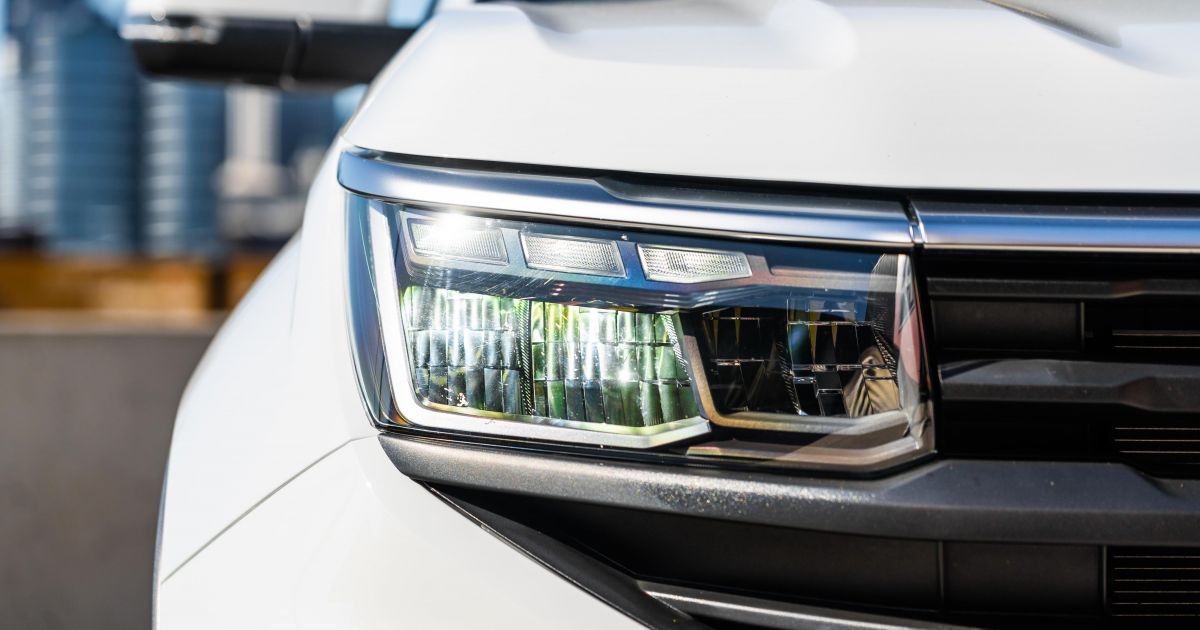
Life -
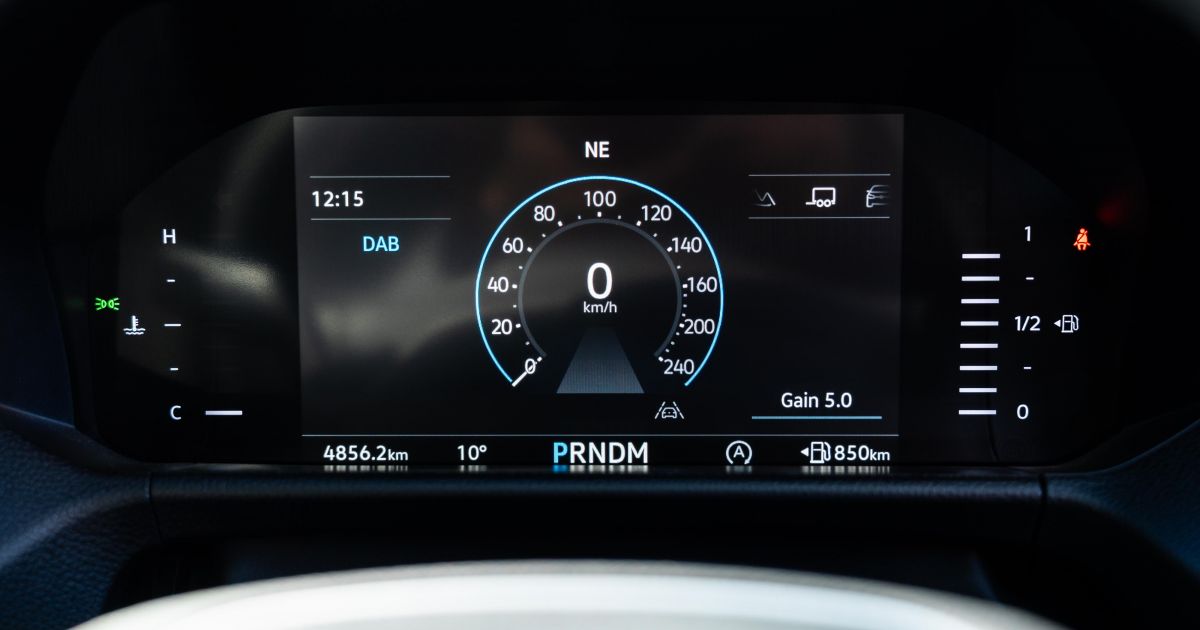
-
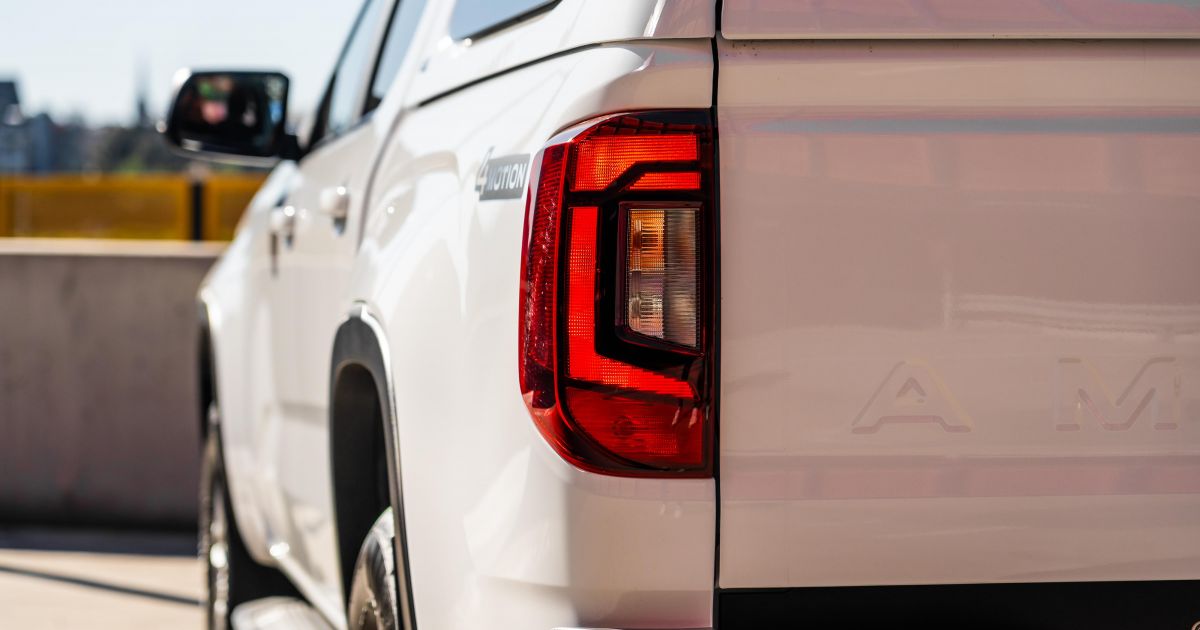
-
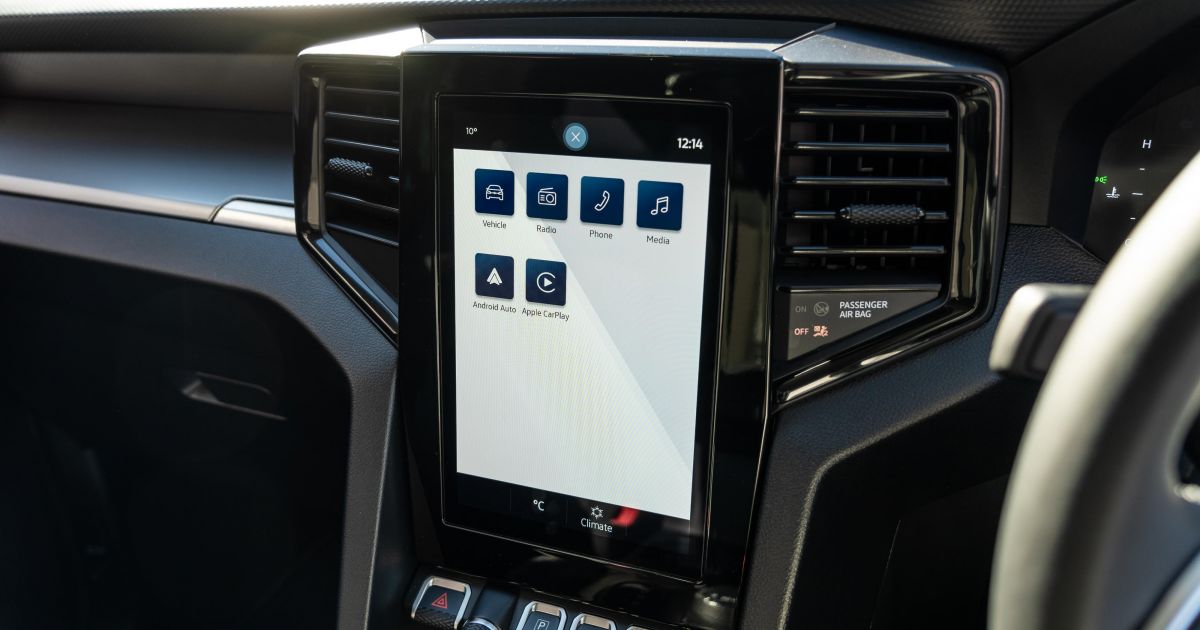
2025 Volkswagen Amarok Core equipment highlights:
- 17-inch ‘Cobra’ alloy wheels
- Front disc, rear drum brakes
- Locking rear differential
- Power-folding side mirrors
- Side steps
- Mud flaps
- 2 x front tow hooks
- Steel underbody protection
- Plastic fuel tank protection
- Tow bar
- 12-pin trailer plug
- Black side mirrors, door handles
- Manual locking tailgate
- 6 x tie-down points in tub (pickup only)
- Exterior tie-down rails
- Cargo box LED lighting (pickup only)
- Automatic LED headlights
- Rain-sensing wipers
- Automatic high-beam
- Halogen tail lights
- Vinyl flooring
- Grey headliner
- Fabric upholstery
- 6-way manual driver seat
- 4-way manual front passenger seat
- 8.0-inch digital instrument cluster
- 10.1-inch touchscreen infotainment system
- Four-speaker sound system
- Wired and wireless Apple CarPlay, Android Auto
- DAB+ digital radio
- Wireless charger
- Single-zone air-conditioning
- Auto-dimming rear-view mirror
- Trailer brake controller
-
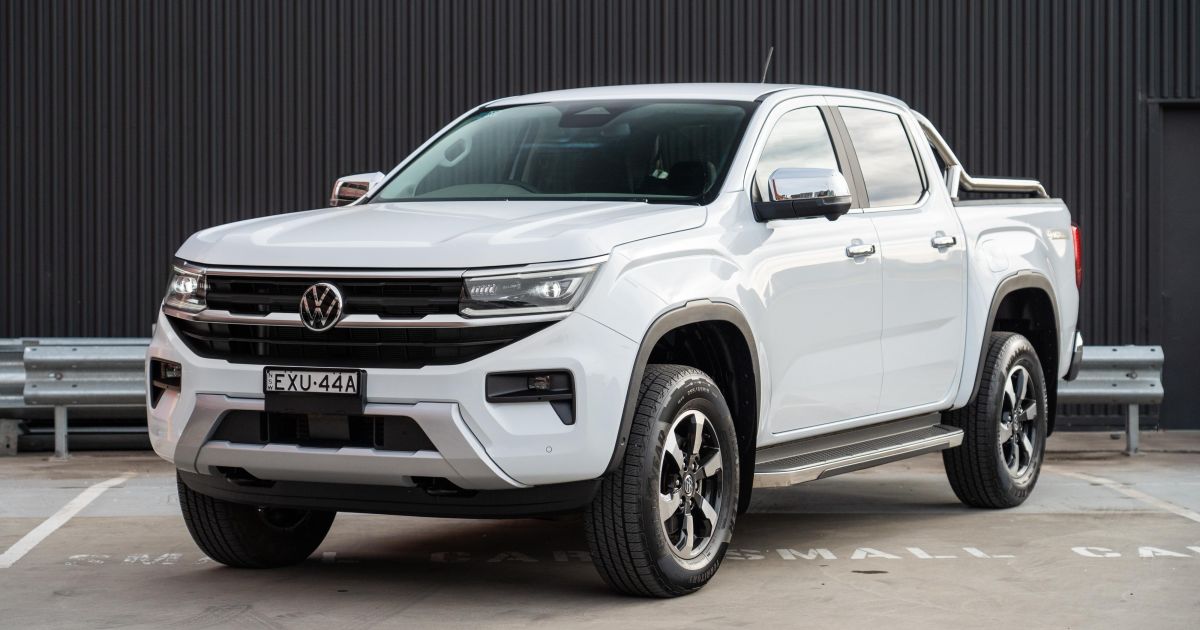
Style -

-
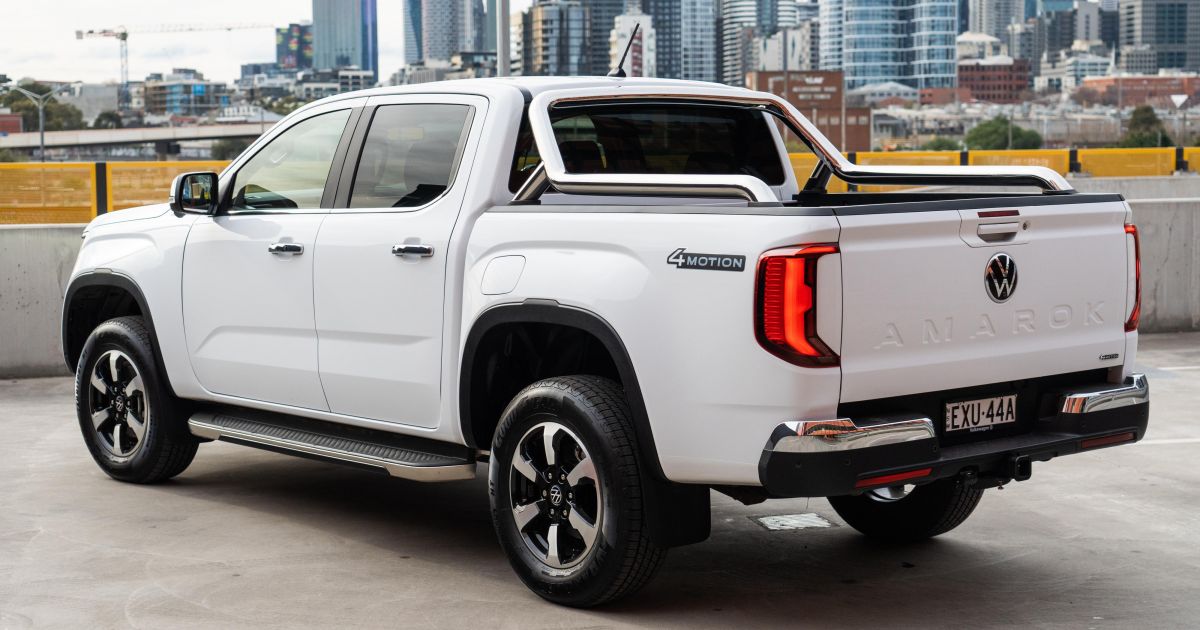
-
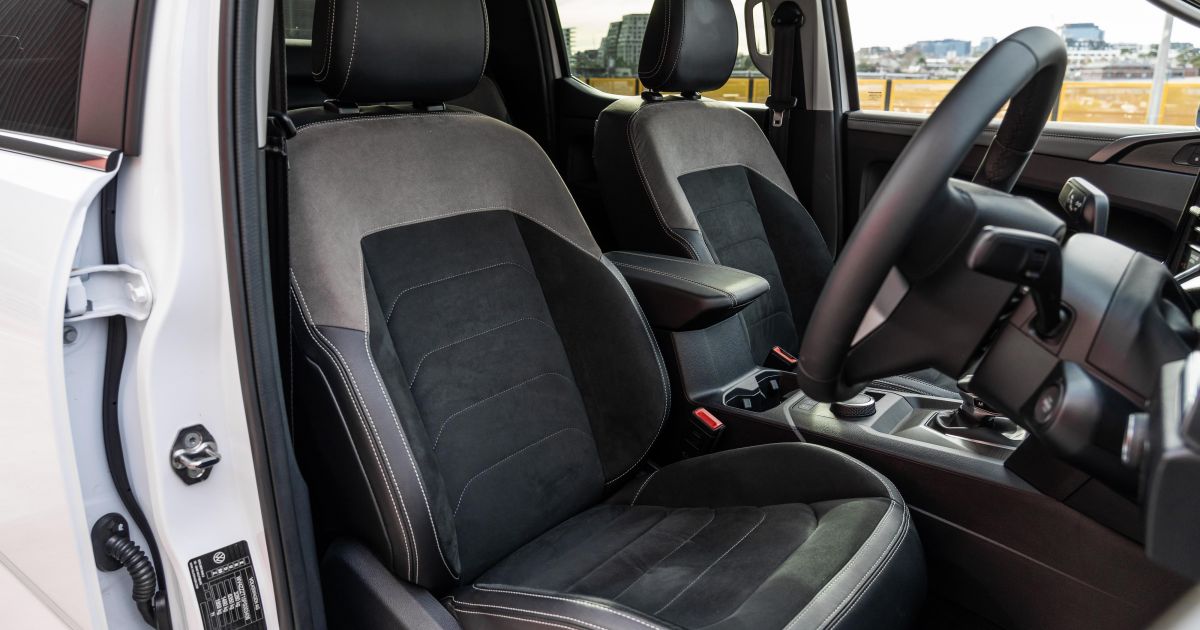
ABOVE: Volkswagen Amarok Style
Amarok Life adds:
- Rear disc brakes
- LED front fog lights
- Body colour side mirrors and door handles
- Heated, power-folding side mirrors with puddle lamps
- Locking wheel nuts
- Tailgate lift assist (pickup only)
- Power tailgate lock (pickup only)
- Privacy glass
- Six-speaker sound system
- E-shifter
- Electric park brake
- Leather-wrapped steering wheel
- Carpet flooring
- Eight-way manual front seats
- Adaptive cruise control with stop/go
Amarok 10 Deserts Edition adds:
- 17-inch black ‘Cobra’ alloy wheels
- Continental CrossContact all-terrain tyres
- 40mm suspension lift (275mm total ground clearance)
- Composite underbody protection
- Black tonneau cover
- 10 Deserts badging
- All-weather floor mats
Amarok Style adds:
- 18-inch ‘Amadora’ alloy wheels
- Chrome side mirrors and door handles
- Plastic tub liner (pickup only)
- Stainless steel sports bar (pickup only)
- 12V socket in tub (pickup only)
- 230V sockets in tub (pickup only)
- 400W inverter
- Matrix LED headlights
- LED tail lights
- Leather-look dashboard and door inserts
- ArtVelour microfibre upholstery
- Heated front seats
- 10-way power driver’s seat
- 12.3-inch digital instrument cluster
- 12.0-inch touchscreen infotainment system
- Dual-zone climate control
- Rear air vents
- Insulated windshield
- Proximity entry and push-button start
- Alarm system
-
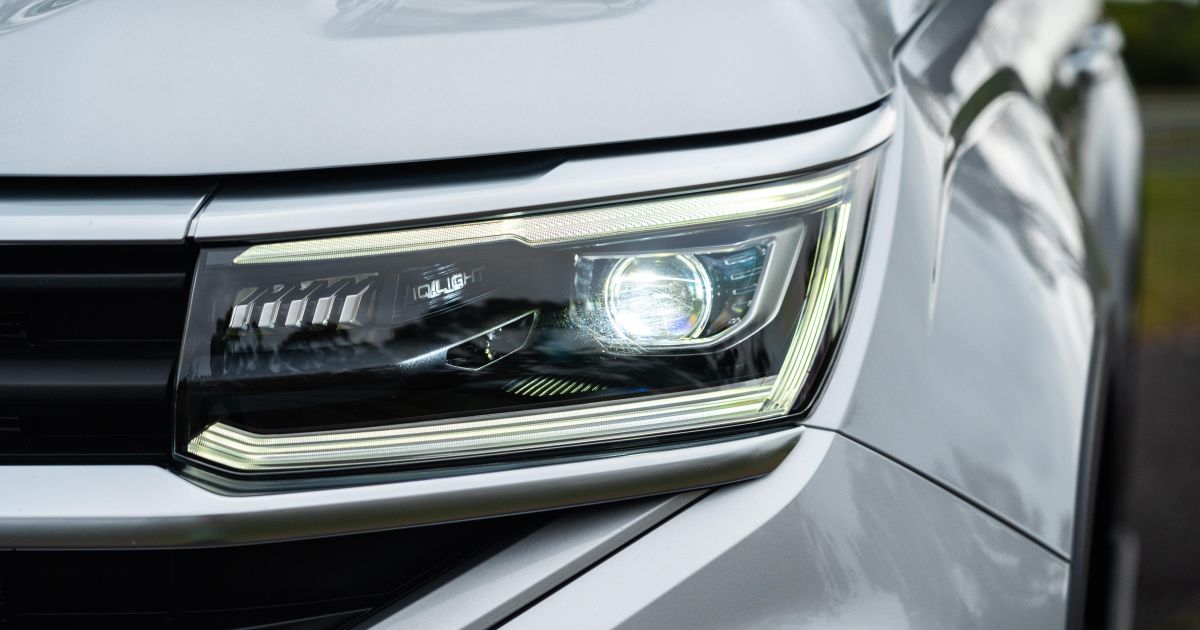
Adventura -
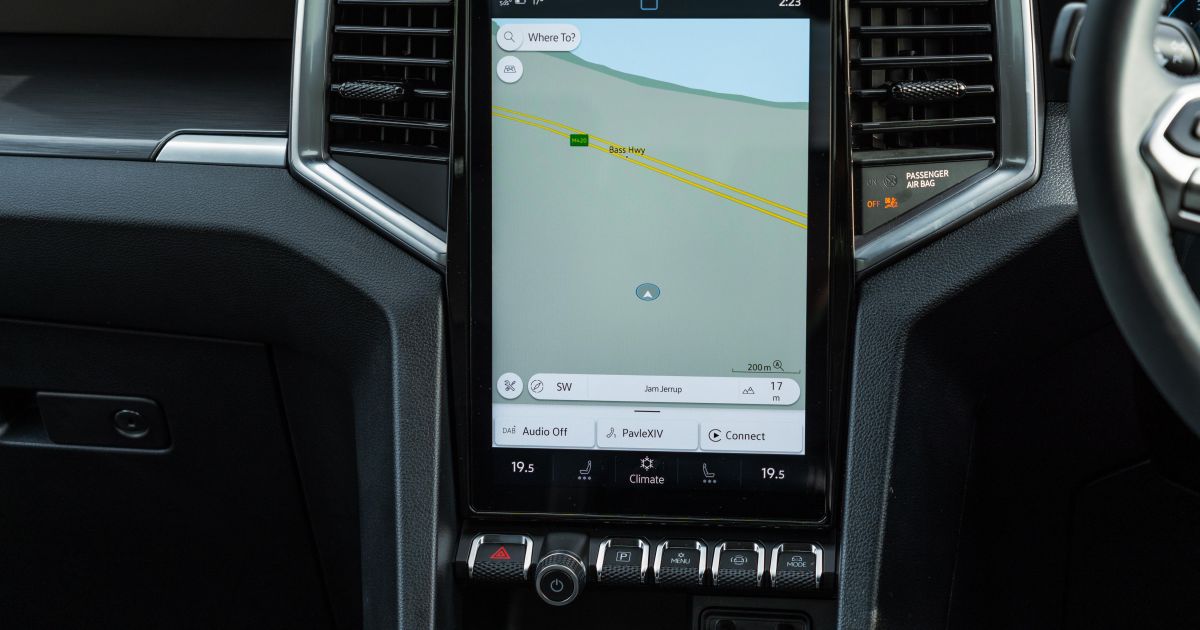
-
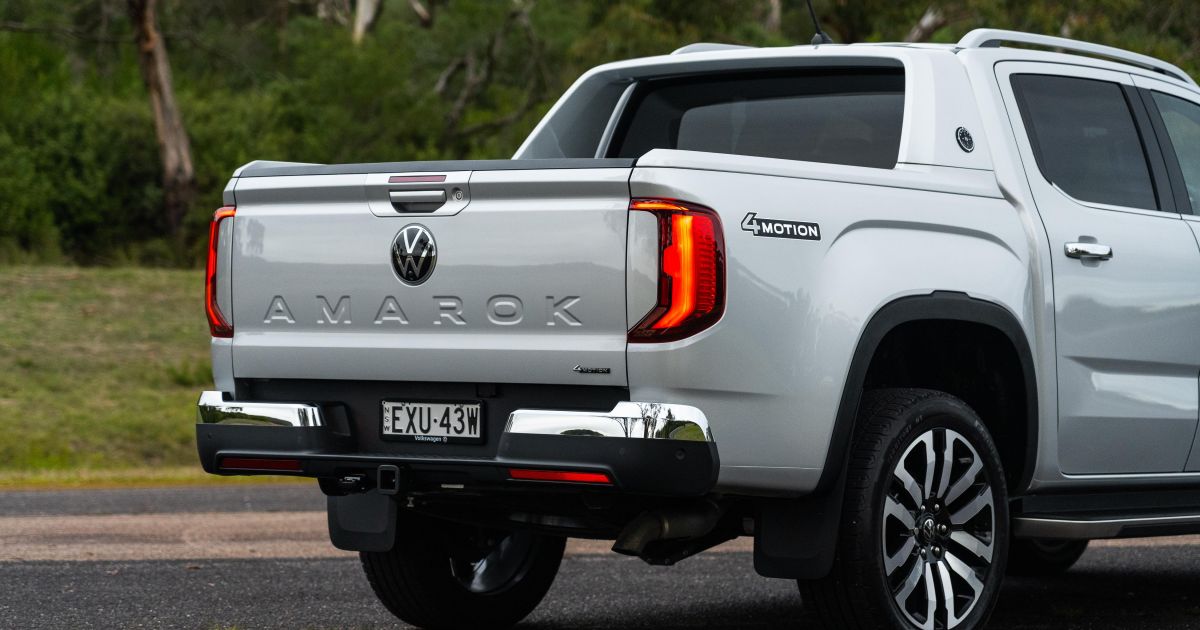
-
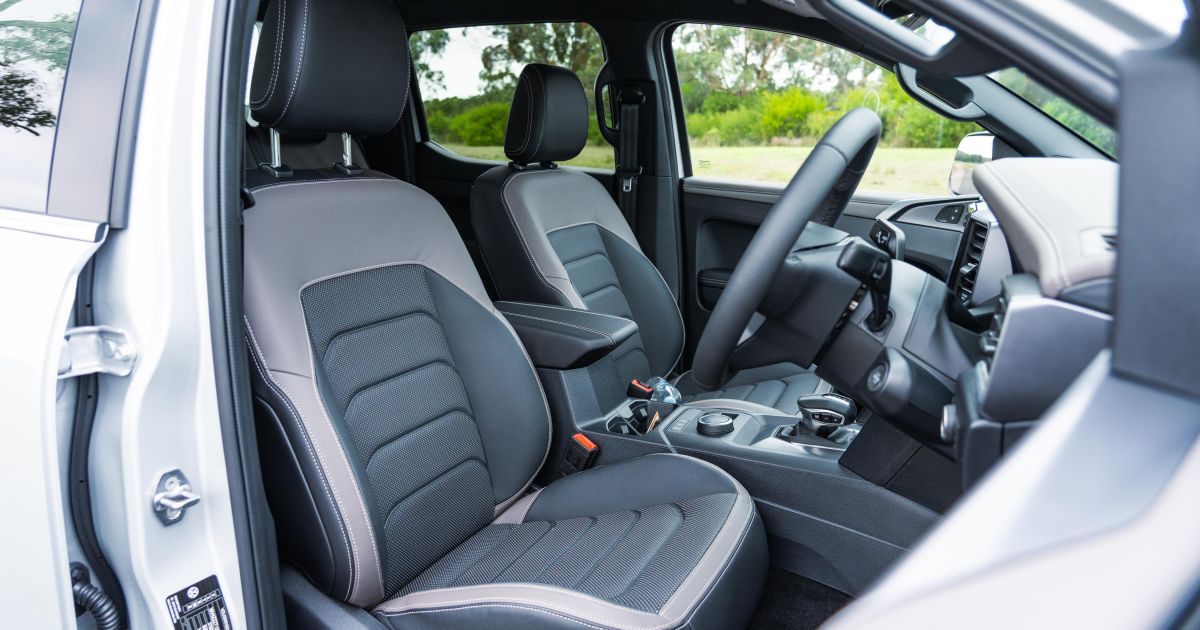
ABOVE: Volkswagen Amarok Aventura
Amarok PanAmericana adds:
- 18-inch black ‘Amadora’ alloy wheels
- All-terrain tyres
- Dynamic suspension
- Black side mirrors and door handles
- PanAmericana decal
- Black sports bar and steps
- Soft tonneau cover
- Roof rails
- Spray-in tub liner
- Leather upholstery
- Power passenger seat
- Eight-speaker Harman Kardon sound system
- Black headliner
Amarok Aventura adds:
- 21-inch ‘Varberg’ alloy wheels
- Chrome bumpers, mirrors, handles
- Rear sailplane
- Electric roller cover
- Leather seats (Savona)
To see how the Amarok stacks up against its rivals, use our comparison tool
Is the Volkswagen Amarok safe?
The Volkswagen Amarok has a five-star ANCAP safety rating based on testing conducted in 2022. This result was drawn from testing of the closely related Ranger, with additional frontal offset and side impact tests conducted on the Amarok by Euro NCAP, which has harmonised testing protocols with ANCAP.
| Category | Volkswagen Amarok |
|---|---|
| Adult occupant protection | 86 per cent |
| Child occupant protection | 93 per cent |
| Vulnerable road user protection | 74 per cent |
| Safety assist | 83 per cent |
Standard safety equipment across the range includes:
- 9 airbags
- Knee
- Centre
- Front
- Side curtain
- Rear
- Adaptive cruise control
- Autonomous emergency braking
- Pedestrian and cyclist detection
- Blind-spot monitoring
- Front, rear parking sensors
- Intelligent Speed Limiter
- Lane-keep assist
- Rear cross-traffic alert
- Reversing camera
- Swerve Steer assist
- Speed sign recognition
- Tyre pressure monitoring
Amarok Life adds:
- Adaptive cruise control with stop-and-go
Amarok Style adds:
- Park Assist semi-autonomous parking
- Surround-view camera
- Trailer assist
To see how the Amarok stacks up against its rivals, use our comparison tool
How much does the Volkswagen Amarok cost to run?
Like the wider Volkswagen Australia range, the Amarok is covered by a five-year, unlimited-kilometre warranty.
| Servicing and Warranty | Volkswagen Amarok |
|---|---|
| Warranty | 5 years, unlimited kilometres |
| Roadside assistance | 12 months free, then service-initiated |
| Service intervals | 12 months or 15,000km |
| Capped price servicing | 5 years |
| Average annual service cost over 5 years | $460.4 |
| Total capped price service cost | $2302 |
Service pricing, accurate as of July 1, 2025, is detailed below:
| Service | Price |
|---|---|
| 12 months, 15,000km | $415 |
| 24 months, 30,000km | $415 |
| 36 months, 45,000km | $539 |
| 48 months, 60,000km | $421 |
| 60 months, 75,000km | $512 |
Alternatively, customers can purchase a five-year ‘Care Plan’ for $2200.
To see how the Amarok stacks up against its rivals, use our comparison tool
CarExpert’s Take on the Volkswagen Amarok Life TDI500
Where other Amaroks cater to lifestyle buyers, the Life is pitched more towards tradies, which is a task it doesn’t take on convincingly.
The MkII Amarok has always been a more premium version of the Ranger. It’s more expensive, but for your money you generally also get nicer materials and the best tech available, even if it comes at the expense of the ‘lifestyle ute’ tag.
But the Life strips things back without a price cut in equal measure. Don’t get us wrong – it’s still a well-built and reliable dual-cab 4×4 pickup, but if you’re going to go for an Amarok at this price you may as well flip a coin with a Ranger XLT, or even an XLS and pay a little less.
It’s not accident there are just four work-oriented variants in the Amarok’s 12-grade lineup.
The Amarok is at its best from the Style level up. Its interior is a much more cohesive package, and it’s generally a little sharper in most areas without compromising too much on its utility.
The bones you get with the Life are undoubtedly solid. It may not be available with the meatier diesel V6, but the biturbo four is still a quality engine with plenty of punch.
That means it can still tow comfortably and offer a very decent payload in the tub. The optional canopy fitted to our tester also improves both storage space and security, offering added peace of mind and turning the Amarok somewhat into the Everest wagon for which Volkswagen has no answer.
The Life TDI500’s interior is also comfortable enough, even if it occupies a weird space between the ruggedness of the Ranger and the SUV-ness of the Amarok PanAmericana, let alone the Aventura.
All that makes the Amarok Life a great ute, but we think tradies are better off saving their cash and buying something else.
Interested in buying a Volkswagen Amarok? Let CarExpert find you the best deal here
Click the images for the full gallery


